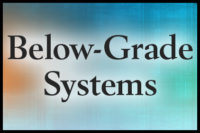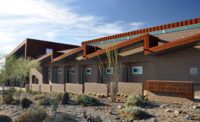
Indiana Tube Corporation has more than 180,000
square feet of manufacturing, storage, warehouse and office space in
Evansville, Ind. When its aging metal roof needed repairs, Preferred
Construction Services Inc. recommended a single-ply recover.
Indiana Tube Corporation is the largest supplier of refrigeration condensers in North America and one of the major suppliers of small diameter, single-wall, low carbon steel tubes. Its products are used by major OEMs around the world in a wide range of industries including automotive, appliance, refrigeration, lawn and garden equipment, off-road vehicles and heavy equipment.
Based in Evansville, Ind., the company has more than 180,000 square feet of manufacturing, storage, warehouse and office space. Its facility is in an industrial metal building that was built in 1973. Over the years, as the company grew, several additions were made to the original building. Today there are seven different structures adjacent to one another that make up the entire plant. Metal buildings are frequently used for manufacturing where machinery and processes can flow without being interrupted by columns or supports. The roofs on metal buildings are typically 24 gauge or 26 gauge standing seam metal panels, fastened to structural purlins five feet on center.

The flutes of the metal roof were filled with
insulation with insulation and covered with JM Invinsa Roof Board.
“Once the roof started to go, we had some significant problems,” said Jeff Raber, maintenance manager for Indiana Tube. “There were sections where the water just poured in every time it rained. In addition, we had to cut out and replace part of the roof over the steel cleaning and plating area, which is a high-humidity environment in the plant.”
As roof problems persisted, Indiana Tube turned to Empire Contractors Inc. of Evansville for advice and input. Empire Contractors frequently works with Preferred Construction Services Inc. of nearby Henderson, Ky. Preferred is one of the area’s leading commercial roofing contractors. On metal buildings such as the Indiana Tube facility, Preferred Construction typically recommends a single-ply recover.
“Replacing metal panels on Indiana Tube was out of the question,” said Dave Coudret, president of Preferred Construction Services. “We are involved with projects of this nature all the time. Recovering metal roofs with a single-ply system not only puts additional insulation for the building, but also provides a good, long-term roofing solution.”
For Indiana Tube, Preferred Construction Services recommended filling the flutes of the metal roof with insulation, covering the entire area with JM Invinsa Roof Board, and then mechanically attaching a Johns Manville PVC roof cover over the top.
Metal roof retrofit projects with single-ply systems can be tricky. A common application is to mechanically fasten the membrane to the purlins, which are typically spaced five-feet on center. This means that contractors either have to purchase special widths of membrane for the application, or use a wider material (i.e., 6 feet or 6.5 feet wide) and leave lots of extra material buried in the seam. In addition, the membrane has to be installed parallel to the purlins.

Workers roll out the 50-mil PVC membrane from
Johns Manville. Preferred used a 6.5-foot-wide membrane for the first phase of
the project and 10-foot-wide membrane for the second phase.
Think Outside the Seam
As an alternative, the RhinoBond System from OMG Roofing Products of Agawam, Mass., was evaluated for the project. RhinoBond is an alternative attachment system for thermoplastic membranes. The system uses advanced induction welding technology to bond the membrane directly to specially coated plates used to secure the insulation or cover board to the roof or purlins. The result is a non-penetrating installation with enhanced wind resistance.RhinoBond offers several benefits for metal retrofit applications. With this system, for example, contractors do not need narrow or special-width materials to match the purlin spacing. In addition, the membrane can be oriented either parallel or perpendicular to the ridge, which makes the installation process easier.
“The RhinoBond system takes the hassle out of metal roof retrofit installations,” said Coudret. “You fill the flutes and install a cover board as normal. Then, rather than installing the membrane, you attach the insulation to the purlins with Rhino plates and fasteners. Those plates provide the attachment points for the membrane, which you then roll out in any direction and secure using the welding tool.”
For the Indiana Tube project, Preferred Construction used a 50-mil PVC Elvaloy KEE membrane from Johns Manville. DuPont’s Elvaloy is an advanced thermoplastic, solid-phase polymer with tough yet flexible properties. It is the workhorse that ensures plasticizer retention, which is critical to having a pliable and durable membrane in even the most extreme environments and essential to long-term performance.
Since this was their first RhinoBond project, Preferred used a 6.5-foot-wide membrane for the first phase of approximately 50,000 square feet. On the second phase of the project - also about 50,000 square feet - Preferred used 10-foot-wide membrane, which improved their productivity rate considerably.

OMG Roofing Products’ RhinoBond system was used
to weld the membrane to the plates. The patented stand-up induction welding
tool bonds the underside of the membrane to the plate.
Welding the membrane to the plates is easy. The RhinoBond system uses a patented stand-up induction welding tool that bonds the underside of the membrane to the plate. Welds typically take five seconds to complete and a magnetic cooling clamp is immediately placed onto the welded plate to assure a strong bond.
“The welder is very easy to use, and OMG Roofing Products trained our crew so we went through the learning curve quickly,” said Coudret. “Our productivity rates were fairly good for this project, particularly considering it was our first RhinoBond job. What really affected us most were weather delays, particularly during the first phase, which we started in November of 2009.”
Besides the insulation and roofing membrane, the project also involved eliminating rooftop penetrations and addressing some drainage issues.
“There were several old exhaust ducts and other items penetrating the roof that were no longer being used,” said Raber. “Every one of them was the source of a leak or two, so as part of the project we removed them all.”
In addition, some of the drains were also causing problems for the building, particularly during the winter months, when they would freeze. To address this, Preferred Construction filled the built-in gutters between the buildings with insulation, installed new retrofit roof drains in the existing drain leaders, and added crickets to the drains for improved water flow.
“RhinoBond is a great system for metal roof retrofit applications,” said Coudret. “We have several projects bid with the system already, and look forward to more opportunities with it.”
For more information about RhinoBond, visit www.rhinobond.com.


